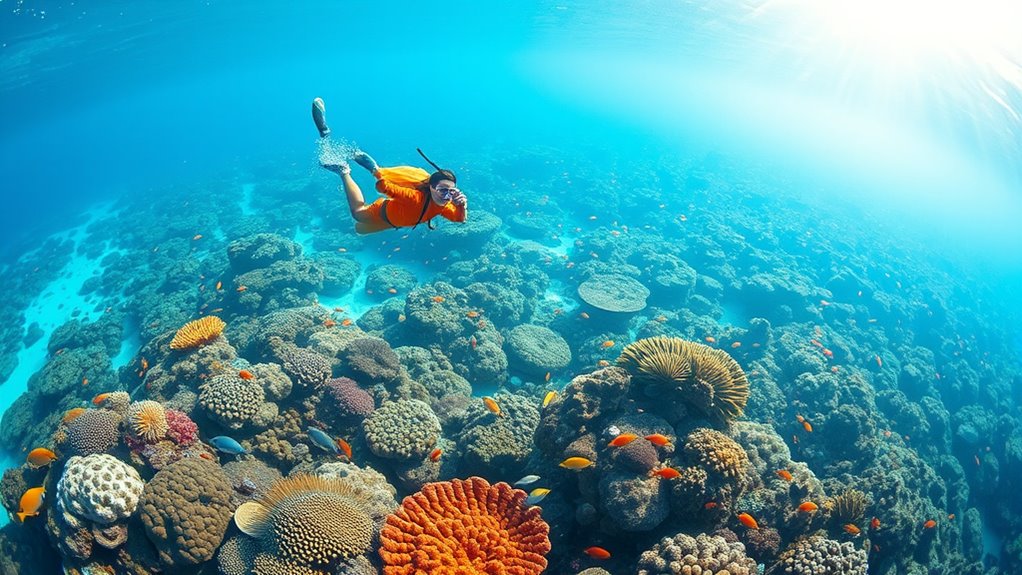To explore reef trails safely, learn how to map and follow natural and artificial markers like coral formations, buoys, and seasonal signs. Use waterproof compasses, GPS devices, and laminated maps to stay on course. Recognize key landmarks and maintain good buoyancy control for smooth navigation. Incorporating technology and observing your environment helps you stay oriented while protecting the reef. Keep skills sharp—continue discovering how to snorkel responsibly and confidently through vibrant underwater paths.
Key Takeaways
- Use waterproof compasses, GPS devices, and laminated maps to accurately navigate and mark reef trails underwater.
- Recognize natural markers like coral formations and artificial buoys to maintain orientation along safe routes.
- Incorporate technology such as digital reef maps and GPS apps for precise trail following and location tracking.
- Practice buoyancy control, slow kicks, and reef-friendly techniques to minimize disturbance and stay on designated paths.
- Follow environmental guidelines by respecting marine life, avoiding coral contact, and using reef-safe products to preserve ecosystems.
Understanding Reef Trails and Their Significance
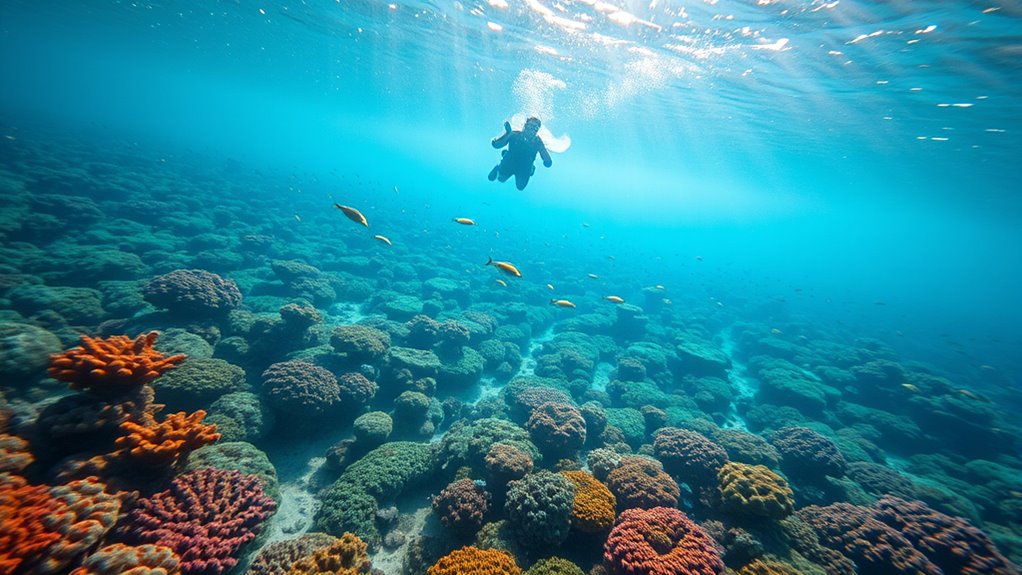
Reef trails are natural pathways that guide snorkelers through vibrant coral ecosystems, making them essential for safe and enjoyable exploration. These trails often follow predictable routes created by currents, natural formations, or areas of abundant marine life. Recognizing reef trails helps you avoid damaging fragile corals while maximizing your viewing experience. They act as underwater highways, leading you past colorful fish, intricate coral structures, and other fascinating marine creatures. By understanding their significance, you can plan your snorkel route more effectively, ensuring you stay within safe zones and don’t get lost. Understanding reef trails also helps conserve the environment by minimizing trampling on sensitive coral areas. Additionally, awareness of zoning and regulations can improve your safety and compliance while exploring different sites. Familiarity with marine navigation techniques can further enhance your ability to explore responsibly and confidently. Overall, they serve as valuable guides that enhance your adventure and protect the underwater ecosystem. Cultivating a growth mindset while exploring can improve your awareness and adaptability in unfamiliar environments. Recognizing the importance of marine protected areas can also help you enjoy your experience responsibly and sustainably.
Essential Equipment for Reef Trail Mapping

To accurately map reef trails, you’ll need waterproof navigation tools that can withstand water exposure. Underwater communication devices help you stay in contact with your team and share important observations. Having the right equipment guarantees your reef trail mapping is precise and safe. Additionally, utilizing high-quality underwater GPS ensures accurate positioning even beneath the surface. Advanced machine learning algorithms can further enhance your trail mapping by processing data more efficiently and identifying patterns in complex reef environments.
Waterproof Navigation Tools
Navigating underwater terrain requires reliable waterproof tools that can withstand the challenging environment. You need equipment that stays functional despite exposure to water, pressure, and corrosion. Essential waterproof navigation tools include:
- Watertight Compasses: Compact, durable compasses designed for underwater use help you maintain your bearings and follow reef trails accurately. These compasses are often designed with high visibility dials and sturdy casings to endure harsh conditions. A precise orientation is vital for successful trail following and safety. Using a compass with a magnetic declination adjustment feature can enhance navigation accuracy in different geographic locations. Additionally, selecting a compass with easy readability ensures quick and accurate readings in low-light conditions.
- Digital GPS Devices: Waterproof GPS units with large screens enable precise location tracking, even beneath the water’s surface. Look for models with high durability and screen visibility in bright conditions to ensure reliable performance.
- Underwater Maps or Charts: Laminated or plastic-coated maps resist water damage, allowing you to plan routes and verify your position without worry. Color accuracy is important for interpreting underwater maps correctly, as true-to-life colors help distinguish different features and depths. In addition, waterproof charts often include detailed depth contours and landmarks to assist in navigation. Using these tools guarantees you stay oriented and on course, making your reef trail mapping accurate and safe. Reliable navigation equipment is crucial for a successful snorkeling adventure.
Underwater Communication Devices
Effective communication is essential when exploring underwater environments, especially during reef trail mapping. Underwater communication devices allow you to stay in contact with your dive buddy or team, ensuring safety and coordination. These devices typically use sound waves or radio signals designed to work underwater, where traditional communication methods fail. Hand-held underwater radios are popular, offering clear audio and simple controls. Advanced options include sonar-based systems or wireless modules linked to your diving gear. Always choose devices that are waterproof, durable, and have sufficient range for your diving conditions. Using these tools helps you share observations, navigate efficiently, and respond quickly to emergencies. Incorporating underwater communication devices into your reef trail mapping gear enhances safety and teamwork, making your exploration more effective and enjoyable. Additionally, selecting appropriate communication technology can significantly improve the overall success of your underwater mapping missions. Understanding underwater sound wave technology is crucial for choosing the right device to ensure reliable communication. Recognizing the importance of marine electronics can further optimize your underwater experience. A good grasp of communication range is also vital to ensure your device meets your specific diving needs.
Reading Reef Topography and Marine Markers
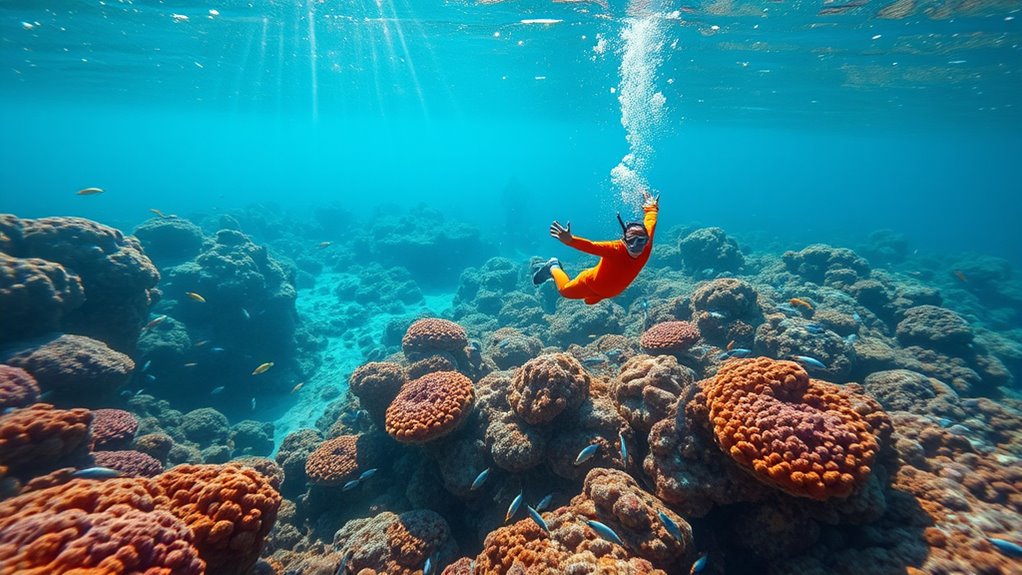
Understanding reef maps helps you recognize the underwater landscape and plan your route. Marine markers like buoys and warning signs guide you along the safest trail. Paying attention to navigational cues guarantees you stay on course and enjoy your snorkeling adventure. Additionally, familiarizing yourself with vetted information about reef features can enhance your safety and overall experience.
Interpreting Reef Maps
Interpreting reef maps is essential for identifying underwater features and ensuring a safe snorkeling experience. By understanding how to read these maps, you can navigate effectively and avoid hazards. Focus on key elements such as contour lines, which indicate depth changes, and symbols that mark specific features. To enhance your skills, consider these aspects:
- Recognize the significance of contour lines to determine the slope and depth of different areas. Map reading skills are crucial for interpreting underwater terrain accurately.
- Familiarize yourself with symbols representing reefs, drop-offs, and underwater structures.
- Assess the scale to estimate distances accurately, helping plan your route and stay within safe zones.
- Remember that passive voice can sometimes obscure who is performing an action, so aim to recognize and revise such constructions for clearer communication.
- Embracing emerging technologies, such as digital reef maps and GPS tracking, can further improve your navigation accuracy and safety during snorkeling adventures. Incorporating these tools can contribute to a more successful exploration experience.
Additionally, understanding the marine environment enhances awareness of potential hazards and safe zones.
Mastering these skills allows you to anticipate the terrain beneath the surface, making your snorkeling more confident and enjoyable.
Recognizing Marine Markers
Have you ever wondered how marine markers guide you through the reef? These markers are natural or artificial signs that help you stay on course. Recognizing them guarantees you don’t get lost or disturb the ecosystem. Look for coral formations, color patterns, and distinctive shapes. Artificial markers like buoys or painted rocks also serve as guides. Being familiar with natural signs like seasonal shifts and animal behavior as weather indicators ensures a safer and more environmentally conscious snorkeling experience. Learning to identify these helps you follow reef trails confidently and safely. The more familiar you become with marine markers, the more you enjoy a smooth, eco-friendly snorkeling adventure. Additionally, understanding reef topography can enhance your navigation skills and deepen your appreciation of the underwater landscape.
Navigational Trail Cues
Ever wonder how experienced snorkelers navigate the complex landscape of a reef? They rely on subtle trail cues embedded in the environment. First, observe natural formations like distinct coral structures or rock outcroppings that serve as landmarks. Second, pay attention to current patterns; they often follow predictable paths along the reef, guiding your movement. Third, look for marine markers such as specific fish groups or coral colors that signal proximity to key features or safe zones. By reading these cues, you can stay oriented and follow reef trails confidently. Combining visual cues with your understanding of reef topography helps prevent disorientation, ensuring a safe and enriching snorkeling experience. Mastering these trail cues makes exploring reefs both intuitive and rewarding.
Techniques for Navigating Underwater Pathways
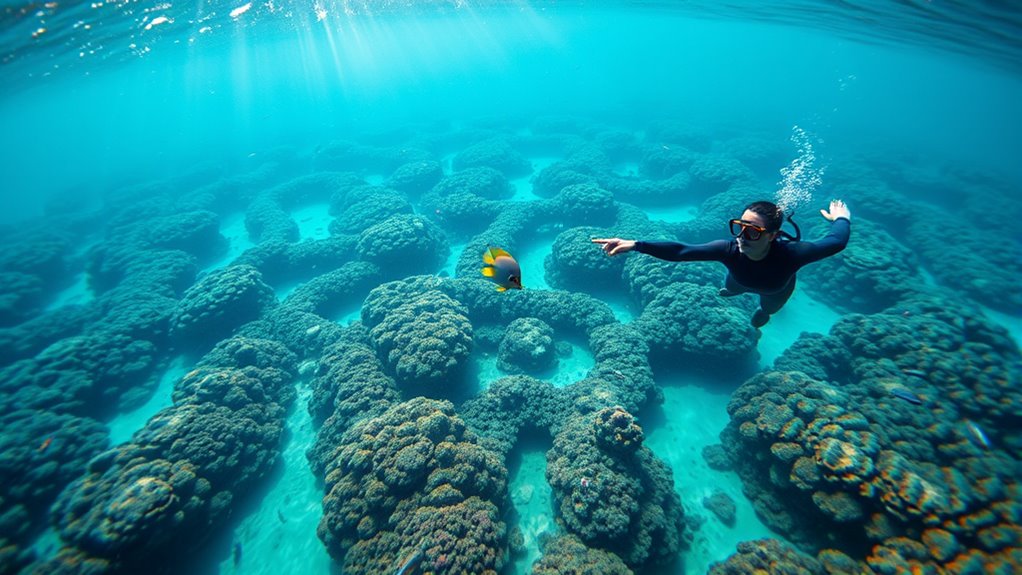
Mastering underwater routes requires a combination of awareness, control, and technique. You need to stay alert to your surroundings and maintain steady movements. Use slow, deliberate kicks to navigate smoothly, avoiding sudden turns that can disorient you. Keep your eyes scanning ahead, noting any subtle changes in terrain or current patterns. To enhance your confidence, practice buoyancy control, so you’re neither rising nor sinking unintentionally. Here’s a quick overview:
| Technique | Effect |
|---|---|
| Slow, controlled kicks | Improves maneuverability and reduces fatigue |
| Maintaining eye contact | Keeps you oriented and aware of surroundings |
| Using hand signals | Communicates intentions clearly |
| Monitoring depth | Prevents disorientation and fatigue |
| Staying relaxed | Allows better control and efficiency |
Using Natural Landmarks and Buoys for Orientation

Using natural landmarks and buoys is essential for maintaining your sense of direction while snorkeling. These features serve as visual cues that help you navigate and avoid getting lost. Pay attention to prominent coral formations, distinctive rock shapes, or unique underwater features that stand out from the surroundings. Additionally, floating or anchored buoys mark specific locations or trail points, offering reliable reference points. To effectively use these aids, consider:
- Memorizing key landmarks before entering the water for quick recognition.
- Noting the position of buoys relative to your entry point to maintain a mental map.
- Checking your surroundings regularly to confirm you’re on the correct trail and avoid straying off course.
Incorporating Technology: Apps and GPS Devices
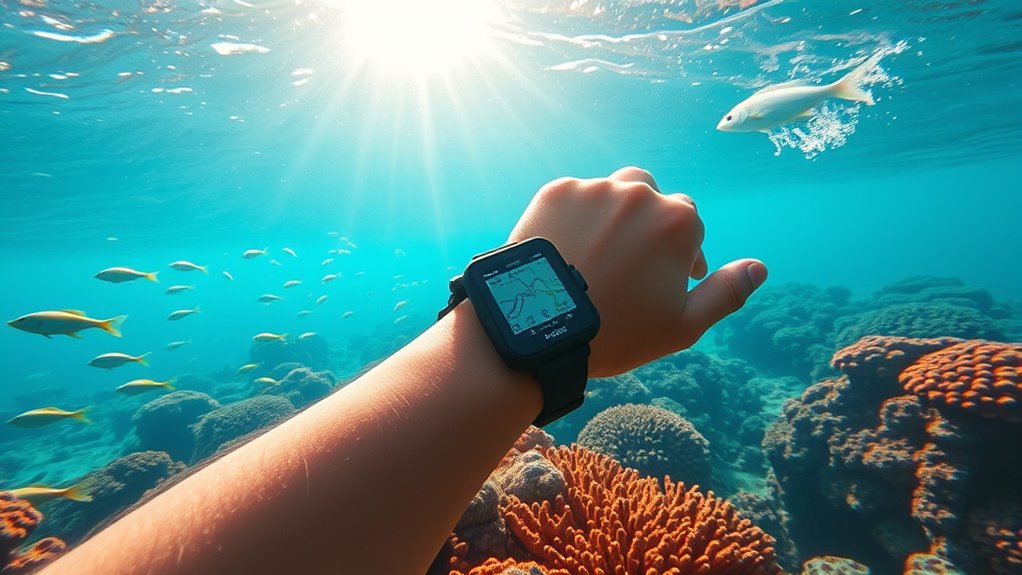
Incorporating technology such as apps and GPS devices can considerably enhance your snorkeling experience by providing precise navigation tools. These tools help you stay on course, discover new reefs, and return safely. With GPS devices, you can mark key spots like entry points or interesting features, ensuring you don’t get lost. Apps often include underwater maps and trail tracking, making navigation straightforward. To maximize their benefits, choose waterproof devices with long battery life. Keep in mind, technology should complement natural navigation skills. Here’s a quick comparison:
| Feature | Benefit |
|---|---|
| GPS Tracking | Marks locations, prevents getting lost |
| Underwater Maps | Visual guidance, easy trail following |
| Battery Life | Ensures devices last through long dives |
| Waterproof Design | Protects tech from water damage |
| User-Friendly Interface | Easy to operate while snorkeling |
Safety Tips for Reef Trail Exploration
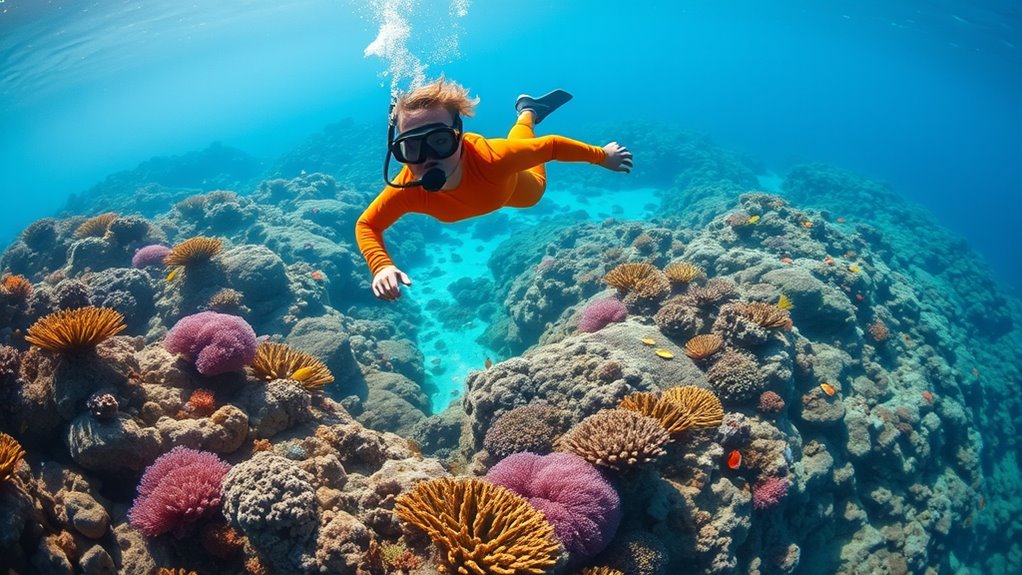
Exploring reef trails can be an incredible experience, but it’s essential to prioritize safety every step of the way. To ensure your adventure remains enjoyable and secure, follow these tips:
Exploring reef trails is amazing—prioritize safety with buddies, awareness, and proper gear for a secure adventure.
- Always snorkel with a buddy to watch out for each other and respond quickly in emergencies.
- Stay within your skill level, avoiding deep or strong currents that could overpower you.
- Keep an eye on your surroundings, avoiding contact with coral to protect both yourself and the reef.
Remember to wear a well-fitted mask, snorkel, and fins, and use a reef-safe sunscreen to prevent sunburn. Carry a waterproof signaling device or whistle, and inform someone on land about your plans. Safety first guarantees many more reef adventures ahead.
Documenting Your Reef Encounters

Have you ever wished you could relive the vibrant moments of your reef adventure? Documenting your encounters helps you preserve those memories. Use waterproof cameras or underwater notebooks to capture fish, corals, and unique formations. Take notes on the location, species, and behaviors you observe. This makes your experience more meaningful and easier to share later. To visualize your trip, imagine this table:
| Reef Feature | Encountered Details |
|---|---|
| Colorful Coral Garden | Bright yellows and purples |
| Schools of Fish | Swift blue tangs and clownfish |
| Unique Marine Life | Gentle sea turtles |
Recording these details enriches your adventure and builds a personal reef journal. Keep your documentation simple, so you can focus on enjoying each moment while capturing the essence of your underwater exploration.
Tips for Respectful and Sustainable Snorkeling

To guarantee your snorkeling adventures benefit the environment, always prioritize respectful and sustainable practices. First, avoid touching or standing on corals; even gentle contact can cause damage. Second, maintain neutral buoyancy to prevent accidental contact with marine life or the seabed. Third, minimize the use of sunscreen—opt for reef-safe products to prevent harmful chemicals from entering the water. Respect local wildlife by observing from a distance and never feeding the fish or other creatures. Keep your fins and equipment streamlined to avoid disturbing the reef. By following these simple steps, you help preserve the delicate ecosystems you’re exploring, ensuring they thrive for future adventures. Your mindful approach makes a meaningful difference in protecting these vibrant underwater worlds.
Frequently Asked Questions
How Do Current and Tides Affect Reef Trail Navigation?
Currents and tides play a big role in reef trail navigation. You’ll find that strong currents can push you off course, making it harder to follow the trail. Tides can also change water levels and visibility, so it’s essential to plan your trip accordingly. By understanding these factors, you can adjust your route, use currents to your advantage, and stay safe while exploring the reef.
What Are Common Signs of Reef Trail Disorientation?
Ever felt lost while exploring underwater? Signs of reef trail disorientation include confusion about your surroundings, difficulty following the trail, and noticing landmarks aren’t where you expect them. You might also feel anxious or lose your sense of direction, especially if currents shift unexpectedly. If you find yourself unsure, stop, check your surroundings, and signal for help if needed. Staying aware helps you stay safe and enjoy your adventure fully.
Can Reef Trails Change Over Time or Due to Environmental Factors?
Reef trails can definitely change over time or due to environmental factors. Currents, storms, and sediment shifts can alter the reef’s structure, making familiar paths difficult to follow. As a snorkeler, you should stay alert and constantly observe your surroundings. Remember, reef environments are dynamic; what was a clear trail yesterday might be different today, so always prioritize safety and navigation skills during your exploration.
How Do I Identify Dangerous Areas Along a Reef Trail?
Think of reef trails as secret garden paths, where danger signs are like hidden thorns. You spot sharp coral, strong currents, or signs of disturbed marine life—they’re your warning flags. Always stay close to your guide, observe your surroundings, and trust your instincts. If something feels off, it’s better to pause and reassess. Recognizing these signals keeps you safe while exploring the beautiful, vibrant underwater world.
What Are Beginner Mistakes to Avoid When Mapping Reef Trails?
When mapping reef trails, you want to avoid common beginner mistakes like not paying attention to current directions, rushing through the process, or neglecting to mark hazards clearly. Stay calm, take your time, and use a waterproof map or guide. Always double-check your trail as you go, and don’t forget to observe the reef environment carefully. These steps help you create accurate, safe trail maps for future adventures.
Conclusion
Now that you know how to map and follow reef trails, you’re ready to plunge in with confidence. Remember, patience and respect for the environment are your best tools—think of it as a dance where every step counts. With the right equipment and a keen eye, you’ll uncover hidden treasures beneath the waves. So grab your gear, stay curious, and enjoy exploring these vibrant underwater pathways—after all, the ocean’s secrets are waiting to be uncovered.

